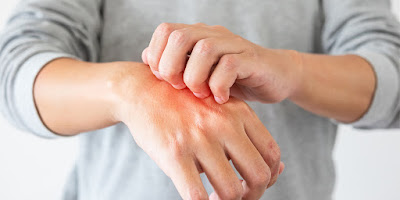Eczema is a collective term for many different skin diseases. All eczema are inflammatory changes in the skin that are not contagious. Dry skin, sweat and environmental substances can lead to eczema. Well-known examples are allergic contact eczema or neurodermatitis.
Eczema is very common, almost everyone gets eczema at some point in their life. Eczema can be temporary or cause permanent symptoms. The defining feature is itching.
Eczema Causes, Risk Factors And Frequency
Both internal (endogenous) and external (exogenous) factors can trigger eczema. An essential, internal factor is the atopy, hereditary predisposition to certain diseases (atopic types, see allergies). These include hay fever, asthma and neurodermatitis (atopic dermatitis, atopic eczema). Atopy is often associated with dry skin. It increases the likelihood of getting eczema because its barrier function is disturbed. Excessive sweating of the feet and hands (hyperhidrosis) can also cause eczema. Sweat may release allergenic substances from socks, shoes or gloves. In addition, excessive sebum production can lead to eczema (seborrheic eczema). Scalp, chest, back and genitals are the areas of the body where this type of eczema occurs.
There are many external factors that irritate the skin and cause eczema. This includes many different substances and circumstances. Allergic contact dermatitis is caused by touching metals such as nickel (in trouser buttons, jewelry or glasses), fragrances in perfumes, creams or other care products and also latex in rubber gloves. Irritant-toxic eczema can form if the skin is overburdened or if it is subjected to too much strain. They are mainly found on hands that are exposed to a lot of moisture and moisture. Leaching substances such as soaps and disinfectants or activities with frequent hand washing are responsible for or worsen the eczema. Occupational groups such as hairdressers, cleaning specialists, nursing staff and workers in the metal or construction industry are particularly at risk, above all irritant-toxic eczema can develop into chronic hand eczema.
Taking some medications, such as antibiotics, while being in the sun can also trigger eczema.
Eczema Symptoms
It begins with reddening of the skin, followed by itching. These symptoms are typical of eczema. All other complaints depend on which parts of the body the skin changes are located on. They also differ depending on the age of the people who have the disease. So there is not one appearance, but many.
Eczema can be temporary (acute) or permanent (chronic). The acute phase begins with a reddened area of skin, which can disappear after a few days in the case of very mild eczema. If the eczema persists, small, pinhead-sized blisters filled with a clear liquid appear. The blisters burst and ooze, then crusts form. The acute phase lasts up to three days.
 | |||
| Eczema Symptoms |
If the eczema does not heal, it turns into a chronic condition. Redness, pustules, crusts and scales appear at the same time. There are also complaints that scratching against the itching triggers and intensifies: the top layer of skin thickens and furrows become coarser. Deep tears and lighter as well as darker skin layers form. The chronic stage does not necessarily have to follow the acute stage, both periods can also occur at the same time. The symptoms overlap.
Complications include bacterial, viral, or fungal infections. They penetrate the body through torn or scratched skin. There they can lead to infections.
Eczema Treatment
The right treatment for eczema depends on the cause of the skin condition. Successful therapy usually has several legs: basic therapy with optimal care products, avoidance of possible triggers, drug treatment.
If the eczema is a contact allergy, the doctor can determine this with a skin test (patch test). If the trigger, for example nickel, is known, clothing or jewelery with the metal can be avoided. The symptoms usually subside on their own after a few days. Chronic eczema can develop with frequent and constant contact with allergy-triggering substances, as may be the case in everyday working life. Inflammatory thickening, cornification and coarsening are characteristic of this. In these cases, too, the best protection is to avoid the allergen. Hairdressers with an allergy to care products or dyes are advised to wear gloves. In the worst cases, only a career change might help. Creams containing cortisone are temporary solutions, since the skin no longer regenerates and becomes thin with long-term use.
Neurodermatitis is treated in different stages depending on the severity. In the case of mild eczema, basic therapy with moisturizing care products can be very effective. Special ingredients such as urea (urea) cause the skin to store more moisture and dry out less. In the case of recurring eczema and itching, the skin areas are treated with ointments and creams containing cortisone. Calcineurin inhibitors may be more appropriate in problem areas such as the face and skin folds. Sometimes antihistamines in tablet form also help against the itching. UV light can alleviate severe, acute and chronic stages. Systemic, i.e. internal therapy, for example with cortisone preparations that influence the immune system, is only carried out in the case of severe eczema diseases.
The right skin care
The basis of every eczema treatment is the basic therapy. Dry skin in particular needs help because it can no longer fulfill its barrier function.
- Too much washing dries out the skin and stresses it. A short, cool shower is better than a long, hot bath. Shower no more than once a day, bathe no more than three times a week. Foam additives also dry out.
- Mild, pH-neutral detergents are better than scented soaps. The more sparingly they are used, the happier the skin.
- Rubbing dry also degreases the skin and irritates it, rather pat dry.
- After cleaning, it is advisable to rub the skin with greasy creams or lotions. These not only give the skin back the lost fats, but also «seal» the moisture that the skin absorbed during the shower or bath.
